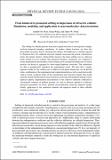From hindered to promoted settling in dispersions of attractive colloids: Simulation, modeling, and application to macromolecular characterization
Author(s)
Fiore, Andrew Michael; Wang, Gang; Swan, James W
DownloadPhysRevFluids.3.063302.pdf (665.8Kb)
PUBLISHER_POLICY
Publisher Policy
Article is made available in accordance with the publisher's policy and may be subject to US copyright law. Please refer to the publisher's site for terms of use.
Terms of use
Metadata
Show full item recordAbstract
The settling of colloidal particles with short-ranged attractions is investigated via highly resolved immersed boundary simulations. At modest volume fractions, we show that intercolloid attractions lead to clustering that reduces the hinderance to settling imposed by fluid back flow. For sufficient attraction strength, increasing the particle concentration grows the particle clusters, which further increases the mean settling rate in a physical mode termed promoted settling. The immersed boundary simulations are compared to recent experimental measurements of the settling rate in nanoparticle dispersions for which particles are driven to aggregate by short-ranged depletion attractions. The simulations are able to quantitatively reproduce the experimental results. We show that a simple, empirical model for the settling rate of adhesive hard-sphere dispersions can be derived from a combination of the experimental and computational data as well as analytical results valid in certain asymptotic limits of the concentration and attraction strength. This model naturally extends the Richardson-Zaki formalism used to describe hindered settling of hard, repulsive spheres. Experimental measurements of the collective diffusion coefficient in concentrated solutions of globular proteins are used to illustrate inference of effective interaction parameters for sticky, globular macromolecules using this empirical model. Finally, application of the simulation methods and empirical model to other colloidal systems are discussed.
Date issued
2018-06Department
Massachusetts Institute of Technology. Department of Chemical EngineeringJournal
Physical Review Fluids
Publisher
American Physical Society
Citation
Fiore, Andrew M. et al. "From hindered to promoted settling in dispersions of attractive colloids: Simulation, modeling, and application to macromolecular characterization." Physical Review Fluids 3, 6 (June 2018): 063302 © 2018 American Physical Society
Version: Final published version
ISSN
2469-990X
2469-9918